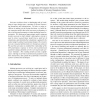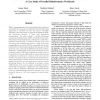HPCA
2006
IEEE
15 years 24 days ago
2006
IEEE
Processor architects have a challenging task of evaluating a large design space consisting of several interacting parameters and optimizations. In order to assist architects in ma...
HPCA
2006
IEEE
15 years 24 days ago
2006
IEEE
Hardware counters are a fundamental building block of modern high-performance processors. This paper explores two applications of probabilistic counter updates, in which the outpu...
HPCA
2006
IEEE
15 years 24 days ago
2006
IEEE
The increasing demand for reliable computers has led to proposals for hardware-assisted rollback of memory state. Such approach promises major reductions in Mean Time To Repair (M...
HPCA
2006
IEEE
15 years 24 days ago
2006
IEEE
With reducing feature size, increasing chip capacity, and increasing clock speed, microprocessors are becoming increasingly susceptible to transient (soft) errors. Redundant multi...
HPCA
2006
IEEE
15 years 24 days ago
2006
IEEE
With the continuing growth in the amount of genetic data, members of the bioinformatics community are developing a variety of data-mining applications to understand the data and d...
HPCA
2006
IEEE
15 years 24 days ago
2006
IEEE
Measurements of an off-the-shelf DRAM chip confirm that different cells retain information for different amounts of time. This result extends to DRAM rows, or pages (retention tim...
HPCA
2006
IEEE
15 years 24 days ago
2006
IEEE
Simulation is an important means of evaluating new microarchitectures. Current trends toward chip multiprocessors (CMPs) try the ability of designers to develop efficient simulato...
HPCA
2006
IEEE
15 years 24 days ago
2006
IEEE
In high-end processors, increasing the number of in-flight instructions can improve performance by overlapping useful processing with long-latency accesses to the main memory. Buf...
HPCA
2006
IEEE
15 years 24 days ago
2006
IEEE
Transactional memory (TM) provides an easy-to-use and high-performance parallel programming model for the upcoming chip-multiprocessor systems. Several researchers have proposed a...
HPCA
2006
IEEE
15 years 24 days ago
2006
IEEE
We propose dynamic scheduler designs to improve the scheduler scalability and reduce its complexity in the SMT processors. Our first design is an adaptation of the recently propos...




